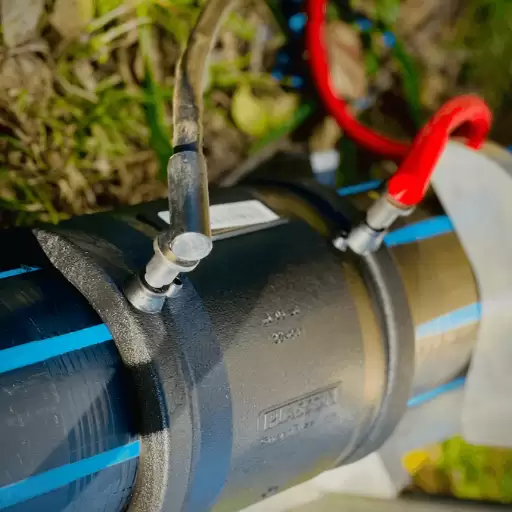The world of piping systems requires us to use some techniques to avoid leaks and ensure safe connections. When it comes to joining polyethylene pipes, most people prefer electrofusion fittings because they are fast and can create reliable connections in high-pressure environments. This blog will discuss the basics of electrofusion fittings, including their function, advantages over traditional welding methods, installation processes, and maintenance issues. By the end of this article, readers will have a comprehensive understanding of electrofusion technology and its critical role in contemporary pipeline engineering.
What is an electrofusion joint?
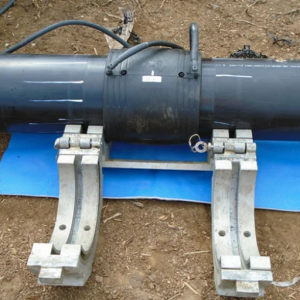
Image source:https://www.jskhdpefittings.com/
Electrofusion fittings are a particular type of fitting designed to join polyethylene (PE) pipes using the electrofusion technique. This method uses fittings with integrated electrical heating elements that, when energized, melt the outer surfaces of the pipe ends and fittings. Upon cooling, the fused materials form a robust and uniform joint. This technology is popular because it ensures reliable connections between dissimilar pipe systems, especially those operating in harsh environmental conditions where conventional welding may not work correctly.
Electrofusion joint details
Precision-engineered electrofusion fittings ensure seamless connections for polyethylene pipes. The fittings are typically made of an inner coil of conductive material that releases heat when an electric current is passed through it. As a result, the thermoplastic materials at the fitting interface are melted and welded together, forming a solid connection that can withstand high pressure and harsh conditions.
One of the great benefits of electrofusion fittings is their versatility. They are suitable for a wide range of pipe diameters and configurations, making them ideal for installing new systems or repairing old ones compared to other types of fittings. They also reduce the chances of human error, as they are simple, and manual work requires less effort than traditional welding methods. Other benefits include reduced installation time and improved joint integrity, especially in harsh conditions, such as those typically encountered by underground pipes or bodies of water.
Therefore, selecting the right type of coupler for the specific application is critical. According to the manufacturer’s instructions, proper installation is necessary to achieve optimal performance and durability. In addition, regular inspections and maintenance activities can make ECs more durable.
Product Description and Application
A synonym of a versatile fitting used in creating secure and durable connections between polyethylene pipes in different applications such as water supply, gas distribution, and sewage systems is an electrofusion coupler. It utilizes integrated heating elements, which cause melting and fusion of the polyethylene under electrical current, leading to a strong bond that can withstand high pressures and mechanical stress. When standard welding may be limited due to space constraints or harsh conditions like extreme temperatures or underwater installations, these bonds benefit new pipeline projects or renovation works. Their use happens across various municipal, industrial, and agricultural setups, indicating their flexibility and reliability in multiple sectors. Proper installation according to manufacturer guidelines and regular maintenance will ensure these joints serve adequately.
HDPE pipe system integration
Integrating HDPE (High-Density Polyethylene) pipe systems into existing infrastructure has advantages and drawbacks. HDPE does not leak because it can fit with other materials, such as steel or concrete, without problems. The specific environmental conditions, pipe diameter, and chemical compatibility of the transported fluids are among the factors to consider during integration.
Secondly, proper joining methods – for example, electrofusion and butt fusion – must be utilized so that there is no failure; otherwise, they will not meet operational standards. Industry recommendations and local regulations must be followed for seamless integration processes to be carried out successfully. Periodic checks on existing piping systems can also enhance efficient plant operations; thus, life spans on HDPE installations may increase even more.
How do Electrofusion Couplers Work?
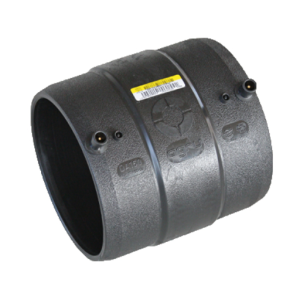
These electrofusion couplers use electrical resistance to generate a heat bond between the HDPE pipe and the coupler. Each coupler has heating elements embedded within that melt when an electric current is applied. The effect of this heat on both the coupler and the pipe’s outer surfaces fuses them when they cool and solidify. Such a method guarantees a strong connection, impervious to leakage, which becomes particularly important under challenging conditions where traditional welding processes are inappropriate. One can obtain dependable connections for diverse applications in municipal and industrial systems by adequately carrying out electrofusion.
Electrofusion process explained
The electrofusion process involves several systematic steps. First, prepare and align the ends of HDPE pipes accurately. Second, an electrofusion coupler is placed around pipe ends to fit tightly on them. The next step involves activating the embedded heating elements by supplying them with electricity. As a result, both surfaces of the coupler and the pipe soften due to this heat, which leads to molecular fusion between them. When the specific heating period is over, the power goes off before allowing cooling to harden, forming a tight joint or union at this endpoint. This technique is known for its reliability and efficiency, especially in areas with limited working space or where conventional welding would be problematic. For instance, adhering strictly to manufacturer instructions is essential during electrofusion.
Why use polyethylene pipes?
Polyethylene pipes have gained popularity in many applications due to various advantages like excellent resistance to corrosion and chemicals to transport fluids under harsh conditions without destruction; their lightweight nature makes installation and handling easy and less labor intensive than traditional materials. The flexibility of polyethylene pipes helps in easy routing around obstacles and minimizes the need for joints, which may compromise the system’s integrity. These pipes are also durable enough for a long life cycle; thus, they perform well in industrial and municipal systems. Ultimately, these factors facilitate the cost-effectiveness and reliability of polyethylene pipes used for modern piping solutions.
Installation steps
- Preparation: You will need several things for this job, such as polyethylene pipes, couplers, a fusion machine, alignment clamps, and safety gear. Ensure your work area is clean and debris-free so the installation goes smoothly.
- Cutting the Pipes: Using a pipe cutter or saw, measure and cut lengths of polyethylene pipes while ensuring straightness and clean edges that properly fit joint areas.
- Cleaning the Surfaces: Use a clean cloth to wipe both ends of your pipe and the inside of the couplers, removing any dirt, moisture, or contaminants that might hinder achieving a fusing solid bond.
- Alignment and Positioning: Join one end of each pipe into its correct coupler while ensuring proper alignment. Use alignment clamps to hold them tightly when you start fusing them.
- Heating and Fusing: After connecting all attached pipes to the fusion machine immediately, set the appropriate temperature and duration according to the manufacturer’s settings until it’s fused completely. Check it closely throughout until it is entirely done before switching off the power source at once.
- Cooling: Allow the joint to cool naturally without any disturbances since the time may vary depending on the diameter of the fused pipe.
- Inspection: After cooling down, visually examine the joint for defects before backfilling or covering the pipes under test pressure.
This will aid in putting up successful and reliable polyethylene piping systems.
Key Features of Electrofusion Fittings
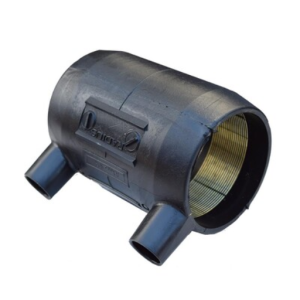
Electrofusion fittings have various advantages which improve the reliability and efficiency of pipe systems:
- Longevity: Created for high pressure and temperature resistance, electrofusion joints are durable in many environments.
- Ease of Installation: Compared to traditional welding practices, the fusion process is simple and does not require much equipment or expertise.
- Leak-Free Joints: This ensures the system remains unaffected by a leaky gap that can cause expensive repairs.
- Compatibility: They fit into various polyethylene pipes for use across multiple applications.
- Less Labour Intensive: Cheaper human resources due to efficient installation that requires fewer people during the fusion process at the site
Understanding these characteristics will enable users to choose wisely when selecting electrofusion fittings for their piping requirements.
Technical specifications and standards
Electrofusion fittings must comply with several technical specifications and standards to be effective. These include ASTM F1055, which lays down the requirements regarding materials, fittings, and installation practices, and ISO 4427, which provides guidelines on PE pipes and water supply systems. By following such industry benchmarks, these products ensure compliance with performance, reliability, and safety standards. Therefore, they are relevant in various uses, including water or gas distribution systems. Specific installation techniques and further details should be referenced in the manufacturer’s guidelines since this may provide additional product-specific information.
Different types of couplers
About electrofusion fittings, a variety of couplers are available for different functions.
- Typical Coupling Devices: These are the most common models for joining polyethylene pipes. They provide a strong joint without leaks and can be used under various pressure ratings.
- Reducing Couplings: These materials are necessary when flow within a piping system is to be altered or redirected through transiting pipe sizes. They are good when the flow must be adjusted or changed.
- Pipe End Caps: Pipe end caps help seal the ends of pipes, prevent contamination, and control flow rates in diverse systems. They also aid in maintaining the integrity of a pipe network during installation and maintenance.
Every coupler is essential in sustaining efficiency, reliability, flexibility, and adaptability for any application within a tube system configuration.
Benefits of PE100 materials
There are several reasons why PE100 materials are ideal for use across multiple industries in plumbing. First, they have excellent toughness alongside impact resistance characteristics, increasing their lifespan even when subjected to harsh conditions. Secondly, PE100 is highly stress crack resistant with low permeability properties, reducing chances of leakage, hence guaranteeing sustainable functionality within water and gas supply networks. Additionally, PE100 tubes weigh less than other materials, thus making them easier to handle and install than traditional options. Moreover, these substances maintain their shape despite temperature variations due to their high thermal expansion coefficient value. Lastly, the construction industry appreciates that PE100 materials contribute towards sustainability initiatives since they can be reused, reducing waste generation during infrastructure development projects. In contrast, its corrosion resistance lowers repair expenses over operational duration.
Common Issues with Electrofusion Couplings and How to Avoid Them
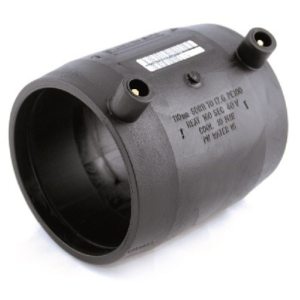
Electrofusion couplings can be a good remedy for joining polyethylene pipes, but a few common challenges may arise during installation. One of them is inadequate surface preparation, which makes joints less intense, resulting in more chances of failure. To prevent this, ensure the pipe ends are clean, dry, and free from contaminants before fusion. Another one is incorrect temperature settings while fusing; it is essential to use appropriate temperature and fusion parameters to achieve a strong bond. Inconsistency or low applied pressure on the couplings leads to visible defects and possible leaks. This risk can be mitigated by maintaining correct pressure throughout the fusion process. Lastly, avoiding environmental factors like extreme weather conditions during installation is essential as they may damage the fusion process negatively. With proper training and adherence to guidelines, these key factors can significantly increase the reliability of electrofusion couplings.
Weld quality controls and tests
Several quality control measures and tests should be performed to maintain the integrity and reliability of electrofusion welds. Firstly, visual inspection is crucial in assessing such joint faults as voids or incomplete fusions by the installers themselves. Secondly, destructive testing methods such as tensile and peel tests provide numerical results on weld strength/ Additionally, ultrasound/infrared thermography offers non-destructive methods that do not cause harm to joints being evaluated for quality assurance purposes only. Furthermore, keeping proper records with detailed documentation, including welding parameters such as temperature or pressure, ensures firms comply with industry standards, thus facilitating quality maintenance, among other benefits associated with quality assurance programs. Long-term education and updates on proper practices for installers will also help improve overall welding quality.
Temperature and pressure parameters
For electrofusion welding to succeed, it is essential to maintain proper temperature and pressure. The recommended fusion temperature is usually between 200°C and 230°C, so the material melts well enough for good bond formation. During the fusion process, stable pressure, which could range between 80-100 psi, must be maintained as an effective means of contact between the fused surfaces. Whenever these conditions are not met, welds will have poor quality with weak joints or failures. Continuous temperature and pressure monitoring should be done throughout the welding processes and equipment calibration to achieve maximum results and meet industrial standards.
Ensuring system integrity
Strong safety measures and adherence to quality control programs that may affect welds and built-in systems should be ensured to guarantee system integrity during welding practices. First, machines should be inspected and maintained to prevent any breakdowns that compromise weld quality. There are also rigorous QA/QC procedures, such as ISO compliance with regular audits for welding techniques audits, that can improve reliability. Lastly, proper welding procedures, including specific materials used under specific environmental conditions, must be followed to ensure system integrity. At the same time, the damage can be minimized by ensuring monitoring technologies like data analytics in real-time alongside feedback mechanisms via automated systems are integrated into structures for welded products before the escalation of problems, keeping them safe for extended durability.
Popular Brands and Recent Products in Electrofusion Technology
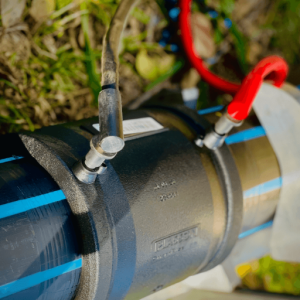
Several brands are famous for their innovative products in the electrofusion technology market. McElroy is a leading company with its Fusion Machine line, which has easy-to-use controls and robust build quality. Georg Fischer is another major player, as it provides different electrofusion fittings and components to guarantee reliable joint integrity. Furthermore, Solenoid has made remarkable progress in electrofusion systems using intelligent technologies that enhance efficiency. Recent products in this field often include advanced connectivity options, such as mobile application incorporation for monitoring and troubleshooting, thus improving user experience and operational efficiency. These brands continue to advance electro-fusion technology with cutting-edge solutions tailored to meet industry demands.
Top brands in the market
- McElroy: This brand is known for high-quality welding equipment, such as its popular Fusion Machine line, which offers updated control features and long-lasting durability for diverse welding applications.
- Georg Fischer: It offers a complete range of high-performance components and electrofusion fittings; the company emphasizes joint reliability and operational efficiency in its product offerings.
- Solenoid: It is recognized for integrating intelligent technologies into its devices, and it is committed to improving user experience by implementing mobile app connectivity, among other considerations, hence easing industry professionals’ work during monitoring and troubleshooting.
These brands consistently innovate beyond current trends, enabling them to remain at the edge of electro-fusion technology development and satisfy the industry’s dynamic needs.
Latest innovations and trends
The automation and improvement of compatibility between devices are the focus of new developments in electrofusion technology. Key trends include fusion machines that are Internet of Things (IoT)-enabled for real-time monitoring and predictive maintenance that hugely improve operational efficiency. In addition, manufacturers are now emphasizing sustainable practices with more attention to green materials and processes during production. There is an increasing demand for integrated software solutions that can support advanced analytics and help users make informed decisions from real-time data. These innovations will lead to increased productivity, decreased downtime, and better safety records across the industry regarding electrofusion applications.
Reference sources
-
Electrofusion Couplers – Strongbridge
This source provides detailed information on using electrofusion couplers to connect pipes that carry water, fluids, and slurries, highlighting their ease of installation and chemical resistance.
Read more -
Electrofusion fittings – integrated piping systems
This brochure details the design, application and testing of electrofusion fittings (including joints) for PE80 and PE100 pipe.
Read more -
4.00″ Electrofusion Fitting, IPS – Millennium
This product page discusses the design and functionality of electrofusion fittings, emphasizing their direct heating interface for secure pipe joining.
Read more
Related articles:Technical description of electrofusion joints



